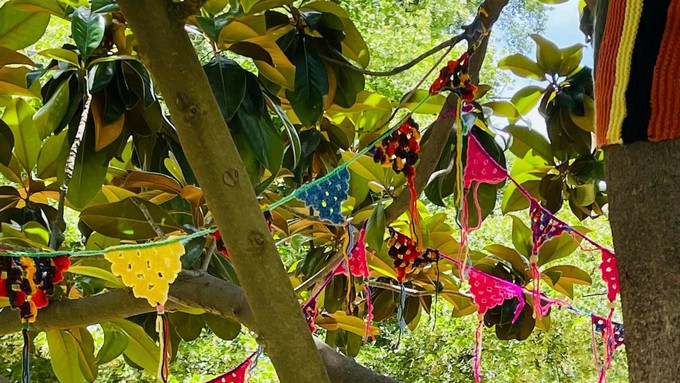
Colorful creations to come down Friday; on Saturday, Shepard Center holds annual meeting

Crocheted yarn flags decorate trees in Sacramento's McKinley Park, thanks to the Sacramento Center for Textile Arts' "yarn bombing." All the yarn art comes down Friday. Courtesy of Sacramento Center for Textile Arts
The 2023 “Yarn Bombing” is complete, announced the Sacramento Center for Textile Arts. It’s time for the McKinley Park trees to go back to being au natural.
Since June 11, colorful yarn creations have decorated the east side of Shepard Garden and Arts Center, Sacramento’s community group clubhouse. The needlework was thanks to SCTA members.
“Even with the loss of a few trees during winter storms, we have displayed our creative artwork around the trees and poles,” noted SCTA president Gloria Robertson in the Shepard newsletter. “Our theme for this year is ‘Faces.’ Our Surface Design Study Group created some whimsical masks to share which are displayed in front of the building on the street side. Thanks to Yvonne Warren and her group! We hope you will visit the area. Enjoy!”
But do it before Friday morning, July 7. That’s when the artists will retrieve their yarn and unmask the trees.
Also this week at Shepard Center, the Friends of Shepard Center will hold their annual meeting at 10 a.m. Saturday. July 8. The meeting is open to the public.
Representatives of the dozens of clubs that call Shepard home will get an update on the center’s finances and elect a new board (each club gets one vote).
Shepard Center recently returned to city management, but retained the same mission. According to its website, “The mission of the Sacramento Garden & Arts Center is to coordinate the efforts and resources of its member clubs and promote an interest in gardening, horticulture, flower arranging, conservation, history, antiques and the arts, including painting, photography, ceramics, metal work, weaving, and other related arts and crafts such as landscape design, architecture, movies, color and design, woodcarving, metal work, mosaics, and other home crafts and the collecting of artifacts.”
Find out more at Saturday’s annual meeting.
Shepard Center is located at 3330 McKinley Blvd., Sacramento, in McKinley Park.
For more details and upcoming events: https://www.sgaac.org/.
Comments
0 comments have been posted.Sacramento Digs Gardening to your inbox.
Food in My Back Yard Series
May 6: Maintain soil moisture with mulch for garden success
April 29: What's (already) wrong with my tomato plants?
April 22: Should you stock up on fertilizer? (Yes!)
April 15: Grow culinary herbs in containers
April 8: When to plant summer vegetables
April 1: Don't be fooled by these garden myths
March 25: Fertilizer tips: How to 'feed' your vegetables for healthy growth
March 18: Time to give vegetable seedlings some more space
March 11: Ways to win the fight against weeds
March 4: Potatoes from the garden
Feb. 25: Plant a fruit tree now -- for later
Feb. 18: How to squeeze more food into less space
Feb. 11: When to plant? Consider staggering your transplants
Feb. 4: Starting in seed starting
Sites We Like
Garden Checklist for week of May 11
Make the most of the lower temperatures early in the week. We’ll be back in the 80s by Thursday.
* Plant, plant, plant! It’s prime planting season in the Sacramento area. Time to set out those tomato transplants along with peppers and eggplants. Pinch off any flowers on new transplants to make them concentrate on establishing roots instead of setting premature fruit.
* Direct-seed melons, cucumbers, summer squash, corn, radishes, pumpkins and annual herbs such as basil.
* Harvest cabbage, lettuce, peas and green onions.
* In the flower garden, direct-seed sunflowers, cosmos, salvia, zinnias, marigolds, celosia and asters. (You also can transplant seedlings for many of the same flowers.)
* Plant dahlia tubers.
* Transplant petunias, marigolds and perennial flowers such as astilbe, columbine, coneflowers, coreopsis, dahlias, rudbeckia and verbena.
* Keep an eye out for slugs, snails, earwigs and aphids that want to dine on tender new growth.
* Feed summer bloomers with a balanced fertilizer.
* For continued bloom, cut off spent flowers on roses as well as other flowering plants.
* Add mulch to the garden to maintain moisture. Mulch also cuts down on weeds. But don’t let it mound around the stems or trunks of trees or shrubs. Leave about a 6-inch-to-1-foot circle to avoid crown rot or other problems.
* Remember to weed! Pull those nasties before they set seed.
* Water early in the day and keep seedlings evenly moist.